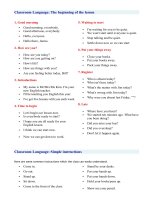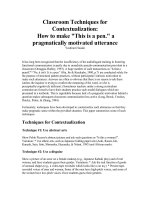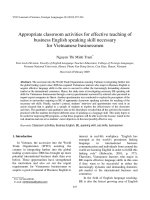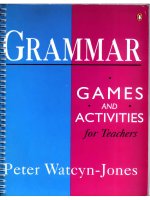Useful Classroom Expressions for Teachers
Bạn đang xem bản rút gọn của tài liệu. Xem và tải ngay bản đầy đủ của tài liệu tại đây (80.44 KB, 8 trang )
Classroom Language: The beginning of the lesson
1. Good morning
• Good morning, everybody.
• Good afternoon, everybody.
• Hello, everyone.
• Hello there, James.
2. How are you?
• How are you today?
• How are you getting on?
• How's life?
• How are things with you?
• Are you feeling better today, Bill?
3. Introductions
• My name is Mr/Mrs/Ms Kim. I'm your
new English teacher.
• I'll be teaching you English this year.
• I've got five lessons with you each week.
4. Time to begin
• Let's begin our lesson now.
• Is everybody ready to start?
• I hope you are all ready for your
English lesson.
• I think we can start now.
• Now we can get down to work.
5. Waiting to start
• I'm waiting for you to be quiet.
• We won't start until everyone is quiet.
• Stop talking and be quiet.
• Settle down now so we can start.
6. Put your things away
• Close your books.
• Put your books away.
• Pack your things away.
7. Register
• Who is absent today?
• Who isn't here today?
• What's the matter with Jim today?
• What's wrong with Jim today?
• Why were you absent last Friday, “”?
8. Late
• Where have you been?
• We started ten minutes ago. What have
you been doing?
• Did you miss your bus?
• Did you oversleep?
• Don't let it happen again.
Classroom Language: Simple instructions
Here are some common instructions which the class can easily understand:
• Come in.
• Go out.
• Stand up.
• Sit down.
• Come to the front of the class.
• Stand by your desks.
• Put your hands up.
• Put your hands down.
• Hold your books/pens up.
• Show me your pencil.
A number of instructions can be used at the beginning of a session:
• Pay attention, everybody.
• You need pencils/rulers.
• We'll learn how to ...
• Are you ready?
• Open your books at page...
• Turn to page ...
• Look at activity five.
• Listen to this tape.
• Repeat after me.
• Again, please.
• Everybody ...
• You have five minutes to do this.
• Who's next?
• Like this, not like that.
A number of instructions can be used at the end of a session:
• It's time to finish.
• Have you finished?
• Let's stop now.
• Stop now.
• Let's check the answers.
• Any questions?
• Collect your work please.
• Pack up your books.
• Are your desks tidy?
• Don't forget to bring your ... tomorrow.
Instructions can also be sequenced:
• First
• Next
• After that
• Then
• Finally
Comprehension language:
• Are you ready?
• Are you with me?
• Are you OK?
• OK so far?
• Do you get it?
• Do you understand?
• Do you follow me?
• What did you say?
• One more time, please.
• Say it again, please.
• I don't understand.
• I don't get it.
• Like this?
• Is this OK?
Classroom Language: The end of the lesson
1. Time to stop
• It's almost time to stop.
• I'm afraid it's time to finish now.
• We'll have to stop here.
• There's the bell. It's time to stop.
5. Homework
• This is your homework for tonight.
• Do exercise 10 on page 23 for your
homework.
• Prepare the next chapter for Monday.
• That's all for today. You can go now.
2. Not time to stop
• The bell hasn't gone yet.
• There are still two minutes to go.
• We still have a couple of minutes left.
• The lesson doesn't finish till five past.
• Your watch must be fast.
• We seem to have finished early.
• We have an extra five minutes.
• Sit quietly until the bell goes.
3. Wait a minute
• Hang on a moment.
• Just hold on a moment.
• Stay where you are for a moment.
• Just a moment, please.
• One more thing before you go.
• Back to your places.
4. Next time
• We'll do the rest of this chapter next time.
• We'll finish this exercise next lesson.
• We've run out of time, so we'll continue
next lesson.
• We'll continue this chapter next Monday.
• There is no homework today.
• Remember your homework.
• Take a worksheet as you leave.
6. Goodbye
• Goodbye, everyone.
• See you again next Wednesday.
• See you tomorrow afternoon.
• See you in room 7 after the break.
• Have a good holiday.
• Enjoy your vacation.
7. Leaving the room
• Get into a queue.
• Form a queue and wait for the bell.
• Everybody outside!
• All of you get outside now!
• Hurry up and get out!
• Try not to make any noise as you leave.
• Be quiet as you leave. Other classes
are still working.
Classroom Language: The language of spontaneous situations
If we use English in spontaneous situations:
• We relate the target language to the learner's immediate environment.
• We take advantage of spontaneous situations to use the target language.
• We exploit contexts which are not directly linked to the syllabus (language in use).
Here are some common situations in which spontaneous English can be used:
• Happy birthday!
• Many returns (of the day).
• I hope you all have a good Christmas.
• Happy New Year!
• “” has his/her 12th birthday today.
• “” is eleven today. Let's sing "Happy
Birthday".
• All the best for the New Year.
• Happy Easter.
• Best of luck.
• Good luck.
• I hope you pass.
• Congratulations!
• Well done!
• Hard lines!
• Never mind.
• Better luck next time.
• Who's not here today?
• Who isn't here?
• What's wrong with ... today?
• Do you feel better today?
• Are you better now?
• Have you been ill?
• What was the matter?
• I'm sorry (about that).
• Sorry, that was my fault.
• I'm terribly sorry.
• Excuse me for a moment.
• I'll be back in a moment.
• Carry on with the exercise while I'm
away.
• I've got to go next door for a moment.
• Excuse me.
• Could I get past please?
• You're blocking the way.
• I can't get past you.
• Get out of the way, please.
• I'm afraid I can't speak any louder.
• I seem to be losing my voice.
• I have a sore throat.
• I have a headache.
• I'm feeling under the weather.
• Do you mind if I sit down?
Classroom Language: The language of classroom management
Here are some common situations in which spontaneous English can be used:
• Make groups of four.
• Move your desks into groups of four people.
• Turn your desks around.
• Make a horseshoe shape with your desks.
• Make a circle with your desks.
• Make a line of desks facing each other.
• Make groups of four desks facing each other.
• Sit back to back.
• Work together with your friend.
• Find a partner.
• Work in pairs/threes/fours/fives.
• Work in groups of two/three/four.
• I want you to form groups.
• Form groups of three.
• Here are some tasks for you to work on
in groups of four.
• There are too many in this group.
• Can you join the other group?
• Only three people in each group.
• I asked for four people to a group.
• Everybody work individually.
• Work by yourselves.
• Work independently.
• Ask your neighbour for help.
• Work on the task together.
• Ask other people in the group.
• Ask others in the class.
• Interview someone else.
• Ask everyone in the class.
• Stand up and find another partner.
• Have you finished?
• Do the next activity.
• Move on to the next activity.
Classroom Language: Language of classroom management
Here are some phrases that can be used for classroom management:
Organization
Giving instructions
• Open your books at page 52.
• Come out and write it on the board.
• Listen to the tape, please.
• Get into groups of four.
• Finish off this song at home.
• Let's sing a song.
• Everybody, please.
• All together now.
• The whole class, please.
• I want you all to join in.
• Could you try the next one?
• I would like you to write this down.
• Would you mind switching the lights on?
• It might be an idea to leave this till next
time.
Sequencing
• First of all, today, ...
• Right. Now we will go on to the next
exercise.
• Have you finished?
• For the last thing today, let's ...
• Whose turn is it to read?
• Which question are you on?
• Next one, please.
• Who hasn't answered yet?
• Let me explain what I want you to do
next.
• The idea of this exercise is for you to ...
• You have ten minutes to do this.
• Your time is up.









